Planetary Boundaries and Planetary Health
VerifiedAdded on 2022/09/11
|8
|2236
|16
AI Summary
Contribute Materials
Your contribution can guide someone’s learning journey. Share your
documents today.

Planetary Boundaries and Planetary Health 1
PLANETARY BOUNDARIES AND PLANETARY HEALTH
Name
Course
Tutor
University
City
Date
PLANETARY BOUNDARIES AND PLANETARY HEALTH
Name
Course
Tutor
University
City
Date
Secure Best Marks with AI Grader
Need help grading? Try our AI Grader for instant feedback on your assignments.
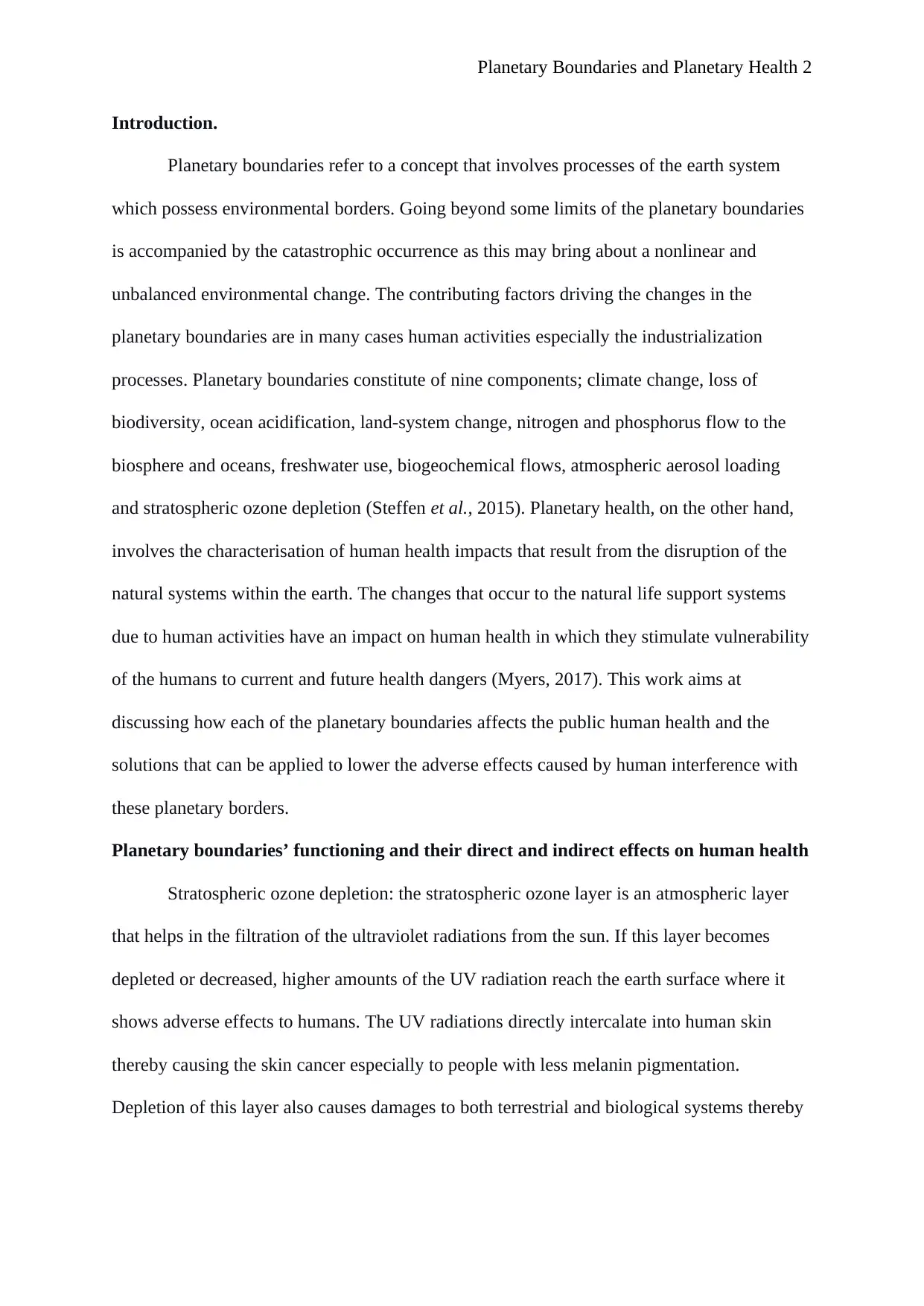
Planetary Boundaries and Planetary Health 2
Introduction.
Planetary boundaries refer to a concept that involves processes of the earth system
which possess environmental borders. Going beyond some limits of the planetary boundaries
is accompanied by the catastrophic occurrence as this may bring about a nonlinear and
unbalanced environmental change. The contributing factors driving the changes in the
planetary boundaries are in many cases human activities especially the industrialization
processes. Planetary boundaries constitute of nine components; climate change, loss of
biodiversity, ocean acidification, land-system change, nitrogen and phosphorus flow to the
biosphere and oceans, freshwater use, biogeochemical flows, atmospheric aerosol loading
and stratospheric ozone depletion (Steffen et al., 2015). Planetary health, on the other hand,
involves the characterisation of human health impacts that result from the disruption of the
natural systems within the earth. The changes that occur to the natural life support systems
due to human activities have an impact on human health in which they stimulate vulnerability
of the humans to current and future health dangers (Myers, 2017). This work aims at
discussing how each of the planetary boundaries affects the public human health and the
solutions that can be applied to lower the adverse effects caused by human interference with
these planetary borders.
Planetary boundaries’ functioning and their direct and indirect effects on human health
Stratospheric ozone depletion: the stratospheric ozone layer is an atmospheric layer
that helps in the filtration of the ultraviolet radiations from the sun. If this layer becomes
depleted or decreased, higher amounts of the UV radiation reach the earth surface where it
shows adverse effects to humans. The UV radiations directly intercalate into human skin
thereby causing the skin cancer especially to people with less melanin pigmentation.
Depletion of this layer also causes damages to both terrestrial and biological systems thereby
Introduction.
Planetary boundaries refer to a concept that involves processes of the earth system
which possess environmental borders. Going beyond some limits of the planetary boundaries
is accompanied by the catastrophic occurrence as this may bring about a nonlinear and
unbalanced environmental change. The contributing factors driving the changes in the
planetary boundaries are in many cases human activities especially the industrialization
processes. Planetary boundaries constitute of nine components; climate change, loss of
biodiversity, ocean acidification, land-system change, nitrogen and phosphorus flow to the
biosphere and oceans, freshwater use, biogeochemical flows, atmospheric aerosol loading
and stratospheric ozone depletion (Steffen et al., 2015). Planetary health, on the other hand,
involves the characterisation of human health impacts that result from the disruption of the
natural systems within the earth. The changes that occur to the natural life support systems
due to human activities have an impact on human health in which they stimulate vulnerability
of the humans to current and future health dangers (Myers, 2017). This work aims at
discussing how each of the planetary boundaries affects the public human health and the
solutions that can be applied to lower the adverse effects caused by human interference with
these planetary borders.
Planetary boundaries’ functioning and their direct and indirect effects on human health
Stratospheric ozone depletion: the stratospheric ozone layer is an atmospheric layer
that helps in the filtration of the ultraviolet radiations from the sun. If this layer becomes
depleted or decreased, higher amounts of the UV radiation reach the earth surface where it
shows adverse effects to humans. The UV radiations directly intercalate into human skin
thereby causing the skin cancer especially to people with less melanin pigmentation.
Depletion of this layer also causes damages to both terrestrial and biological systems thereby

Planetary Boundaries and Planetary Health 3
causing an indirect health implication to humans due to decreased sources of the products
produced by the affected systems (Williamson et al., 2019).
Loss of biosphere integrity: biodiversity describes all living things in a single
ecosystem, including the number and species variation and all aspects of the environment
including the levels of temperature, oxygen and carbon dioxide. Biodiversity loss arises from
human activities aiming at increasing the availability of food, water, and natural resources.
The overall effect is the overexploitation of certain natural resources leading to their
extinction. Human health relies on ecosystem products and services. Therefore, a direct
health impact is felt as such ecosystem products are inadequate. Indirectly, human health is
affected by biodiversity loss because of the changes in the ecosystem that may also affect
local migration livelihoods as well as the income. Besides, important discoveries in
medicines are made from understanding the biodiversity of the earth. Therefore, loss of
biodiversity implies a limitation to discoveries of treatment tools for a variety of disease
(Wardle, 2016).
Ocean acidification: one-quarter of carbon dioxide emitted by human activities end up
being dissolved in oceans thereby forming carbonic acid of the oceans. This raises the acidity
which in turn reduce carbonate availability which leads to the hardness of the formation of
structures like shell and skeleton by the marine species. Additionally, increased acidity
prevents the growth and survival of marine species such as shellfish and planktons.
Consumption of ocean plates of seafood is accompanied by lots of health benefits such as the
provision of polyunsaturated fatty acids from seafood. Human health is therefore indirectly
affected as important seafood may not be produced due to the inhibition effect produced by
the high acidity in the oceans towards the ocean and sea organisms (Clements and Chopin,
2017).
causing an indirect health implication to humans due to decreased sources of the products
produced by the affected systems (Williamson et al., 2019).
Loss of biosphere integrity: biodiversity describes all living things in a single
ecosystem, including the number and species variation and all aspects of the environment
including the levels of temperature, oxygen and carbon dioxide. Biodiversity loss arises from
human activities aiming at increasing the availability of food, water, and natural resources.
The overall effect is the overexploitation of certain natural resources leading to their
extinction. Human health relies on ecosystem products and services. Therefore, a direct
health impact is felt as such ecosystem products are inadequate. Indirectly, human health is
affected by biodiversity loss because of the changes in the ecosystem that may also affect
local migration livelihoods as well as the income. Besides, important discoveries in
medicines are made from understanding the biodiversity of the earth. Therefore, loss of
biodiversity implies a limitation to discoveries of treatment tools for a variety of disease
(Wardle, 2016).
Ocean acidification: one-quarter of carbon dioxide emitted by human activities end up
being dissolved in oceans thereby forming carbonic acid of the oceans. This raises the acidity
which in turn reduce carbonate availability which leads to the hardness of the formation of
structures like shell and skeleton by the marine species. Additionally, increased acidity
prevents the growth and survival of marine species such as shellfish and planktons.
Consumption of ocean plates of seafood is accompanied by lots of health benefits such as the
provision of polyunsaturated fatty acids from seafood. Human health is therefore indirectly
affected as important seafood may not be produced due to the inhibition effect produced by
the high acidity in the oceans towards the ocean and sea organisms (Clements and Chopin,
2017).
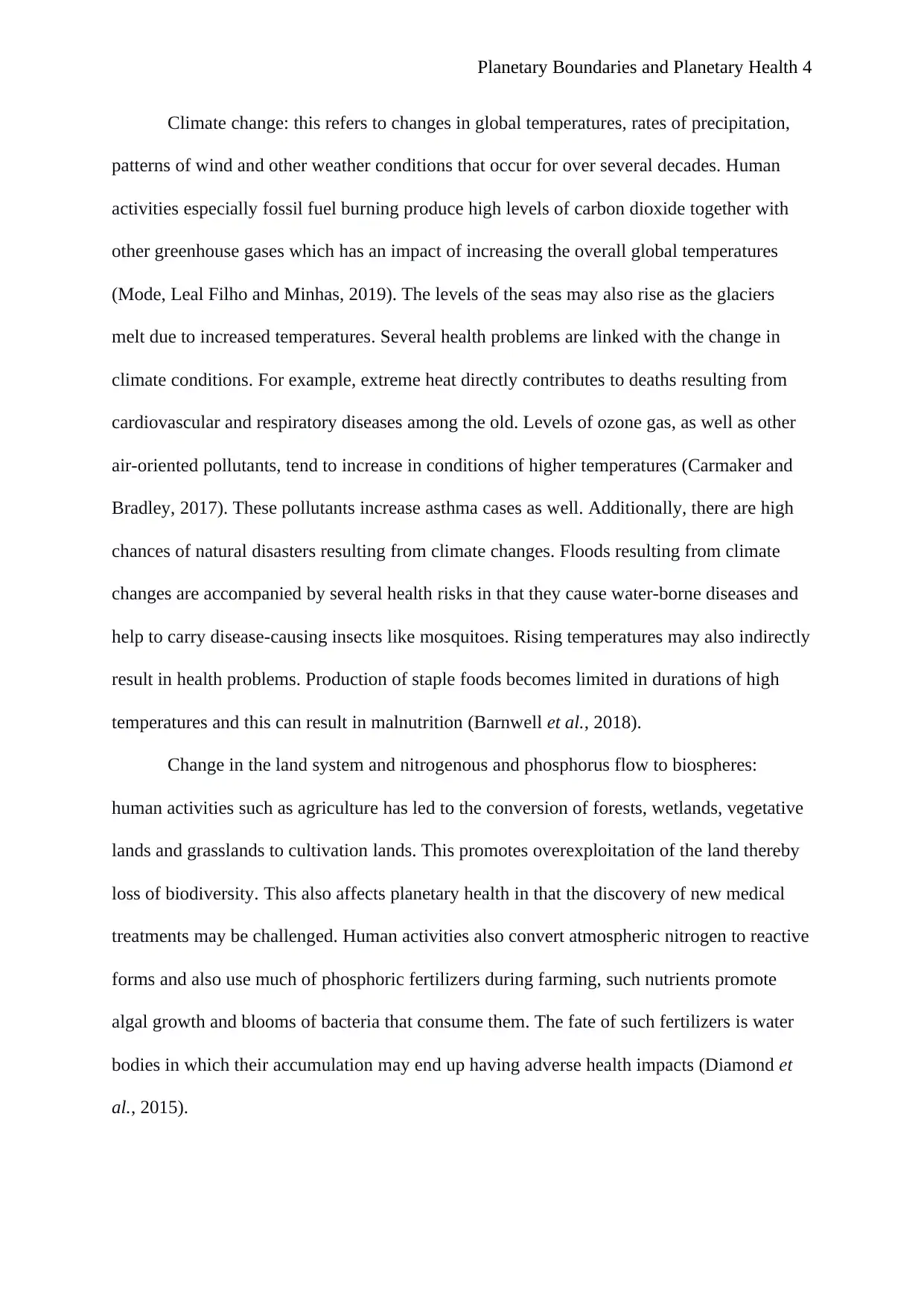
Planetary Boundaries and Planetary Health 4
Climate change: this refers to changes in global temperatures, rates of precipitation,
patterns of wind and other weather conditions that occur for over several decades. Human
activities especially fossil fuel burning produce high levels of carbon dioxide together with
other greenhouse gases which has an impact of increasing the overall global temperatures
(Mode, Leal Filho and Minhas, 2019). The levels of the seas may also rise as the glaciers
melt due to increased temperatures. Several health problems are linked with the change in
climate conditions. For example, extreme heat directly contributes to deaths resulting from
cardiovascular and respiratory diseases among the old. Levels of ozone gas, as well as other
air-oriented pollutants, tend to increase in conditions of higher temperatures (Carmaker and
Bradley, 2017). These pollutants increase asthma cases as well. Additionally, there are high
chances of natural disasters resulting from climate changes. Floods resulting from climate
changes are accompanied by several health risks in that they cause water-borne diseases and
help to carry disease-causing insects like mosquitoes. Rising temperatures may also indirectly
result in health problems. Production of staple foods becomes limited in durations of high
temperatures and this can result in malnutrition (Barnwell et al., 2018).
Change in the land system and nitrogenous and phosphorus flow to biospheres:
human activities such as agriculture has led to the conversion of forests, wetlands, vegetative
lands and grasslands to cultivation lands. This promotes overexploitation of the land thereby
loss of biodiversity. This also affects planetary health in that the discovery of new medical
treatments may be challenged. Human activities also convert atmospheric nitrogen to reactive
forms and also use much of phosphoric fertilizers during farming, such nutrients promote
algal growth and blooms of bacteria that consume them. The fate of such fertilizers is water
bodies in which their accumulation may end up having adverse health impacts (Diamond et
al., 2015).
Climate change: this refers to changes in global temperatures, rates of precipitation,
patterns of wind and other weather conditions that occur for over several decades. Human
activities especially fossil fuel burning produce high levels of carbon dioxide together with
other greenhouse gases which has an impact of increasing the overall global temperatures
(Mode, Leal Filho and Minhas, 2019). The levels of the seas may also rise as the glaciers
melt due to increased temperatures. Several health problems are linked with the change in
climate conditions. For example, extreme heat directly contributes to deaths resulting from
cardiovascular and respiratory diseases among the old. Levels of ozone gas, as well as other
air-oriented pollutants, tend to increase in conditions of higher temperatures (Carmaker and
Bradley, 2017). These pollutants increase asthma cases as well. Additionally, there are high
chances of natural disasters resulting from climate changes. Floods resulting from climate
changes are accompanied by several health risks in that they cause water-borne diseases and
help to carry disease-causing insects like mosquitoes. Rising temperatures may also indirectly
result in health problems. Production of staple foods becomes limited in durations of high
temperatures and this can result in malnutrition (Barnwell et al., 2018).
Change in the land system and nitrogenous and phosphorus flow to biospheres:
human activities such as agriculture has led to the conversion of forests, wetlands, vegetative
lands and grasslands to cultivation lands. This promotes overexploitation of the land thereby
loss of biodiversity. This also affects planetary health in that the discovery of new medical
treatments may be challenged. Human activities also convert atmospheric nitrogen to reactive
forms and also use much of phosphoric fertilizers during farming, such nutrients promote
algal growth and blooms of bacteria that consume them. The fate of such fertilizers is water
bodies in which their accumulation may end up having adverse health impacts (Diamond et
al., 2015).
Secure Best Marks with AI Grader
Need help grading? Try our AI Grader for instant feedback on your assignments.
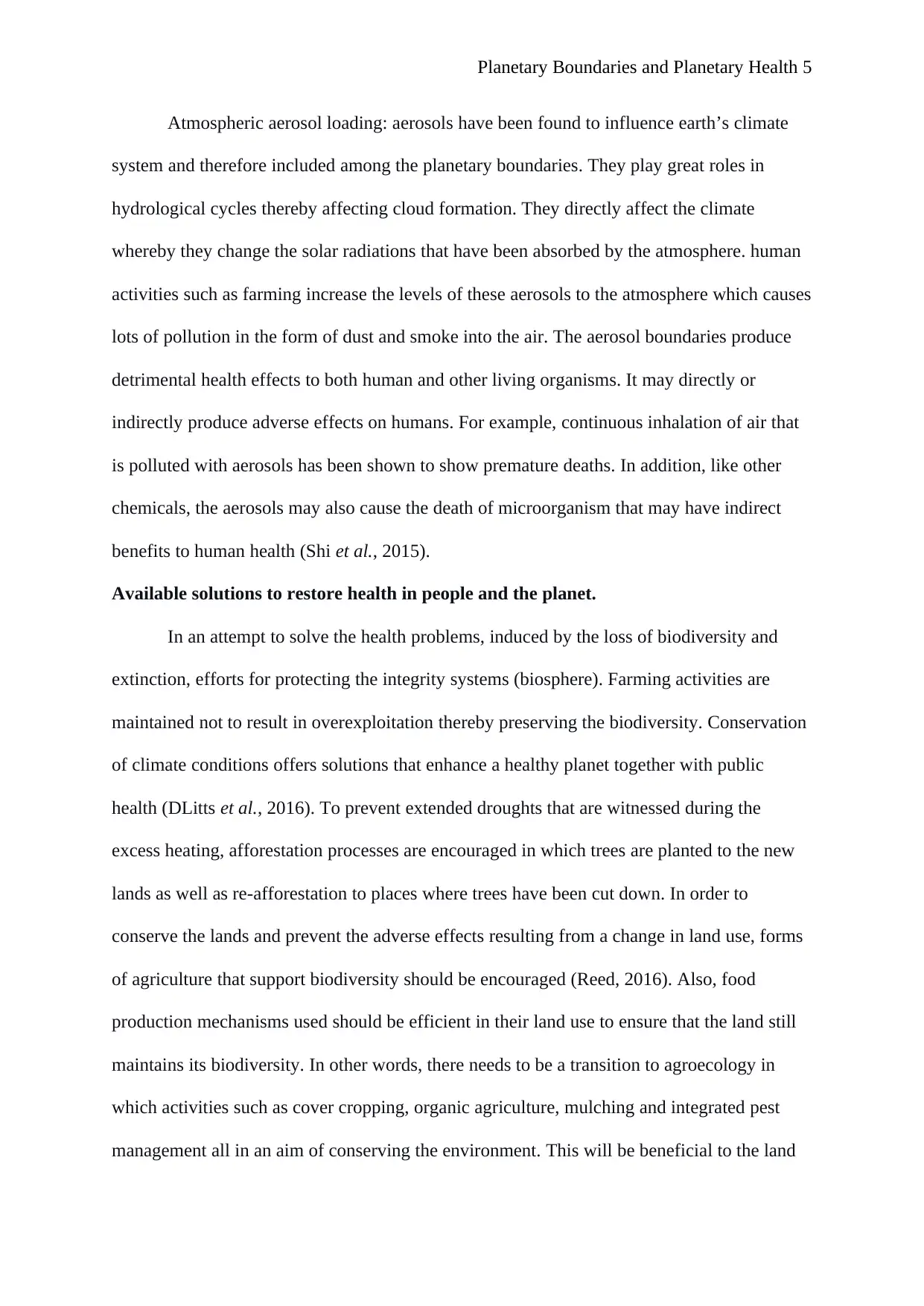
Planetary Boundaries and Planetary Health 5
Atmospheric aerosol loading: aerosols have been found to influence earth’s climate
system and therefore included among the planetary boundaries. They play great roles in
hydrological cycles thereby affecting cloud formation. They directly affect the climate
whereby they change the solar radiations that have been absorbed by the atmosphere. human
activities such as farming increase the levels of these aerosols to the atmosphere which causes
lots of pollution in the form of dust and smoke into the air. The aerosol boundaries produce
detrimental health effects to both human and other living organisms. It may directly or
indirectly produce adverse effects on humans. For example, continuous inhalation of air that
is polluted with aerosols has been shown to show premature deaths. In addition, like other
chemicals, the aerosols may also cause the death of microorganism that may have indirect
benefits to human health (Shi et al., 2015).
Available solutions to restore health in people and the planet.
In an attempt to solve the health problems, induced by the loss of biodiversity and
extinction, efforts for protecting the integrity systems (biosphere). Farming activities are
maintained not to result in overexploitation thereby preserving the biodiversity. Conservation
of climate conditions offers solutions that enhance a healthy planet together with public
health (DLitts et al., 2016). To prevent extended droughts that are witnessed during the
excess heating, afforestation processes are encouraged in which trees are planted to the new
lands as well as re-afforestation to places where trees have been cut down. In order to
conserve the lands and prevent the adverse effects resulting from a change in land use, forms
of agriculture that support biodiversity should be encouraged (Reed, 2016). Also, food
production mechanisms used should be efficient in their land use to ensure that the land still
maintains its biodiversity. In other words, there needs to be a transition to agroecology in
which activities such as cover cropping, organic agriculture, mulching and integrated pest
management all in an aim of conserving the environment. This will be beneficial to the land
Atmospheric aerosol loading: aerosols have been found to influence earth’s climate
system and therefore included among the planetary boundaries. They play great roles in
hydrological cycles thereby affecting cloud formation. They directly affect the climate
whereby they change the solar radiations that have been absorbed by the atmosphere. human
activities such as farming increase the levels of these aerosols to the atmosphere which causes
lots of pollution in the form of dust and smoke into the air. The aerosol boundaries produce
detrimental health effects to both human and other living organisms. It may directly or
indirectly produce adverse effects on humans. For example, continuous inhalation of air that
is polluted with aerosols has been shown to show premature deaths. In addition, like other
chemicals, the aerosols may also cause the death of microorganism that may have indirect
benefits to human health (Shi et al., 2015).
Available solutions to restore health in people and the planet.
In an attempt to solve the health problems, induced by the loss of biodiversity and
extinction, efforts for protecting the integrity systems (biosphere). Farming activities are
maintained not to result in overexploitation thereby preserving the biodiversity. Conservation
of climate conditions offers solutions that enhance a healthy planet together with public
health (DLitts et al., 2016). To prevent extended droughts that are witnessed during the
excess heating, afforestation processes are encouraged in which trees are planted to the new
lands as well as re-afforestation to places where trees have been cut down. In order to
conserve the lands and prevent the adverse effects resulting from a change in land use, forms
of agriculture that support biodiversity should be encouraged (Reed, 2016). Also, food
production mechanisms used should be efficient in their land use to ensure that the land still
maintains its biodiversity. In other words, there needs to be a transition to agroecology in
which activities such as cover cropping, organic agriculture, mulching and integrated pest
management all in an aim of conserving the environment. This will be beneficial to the land
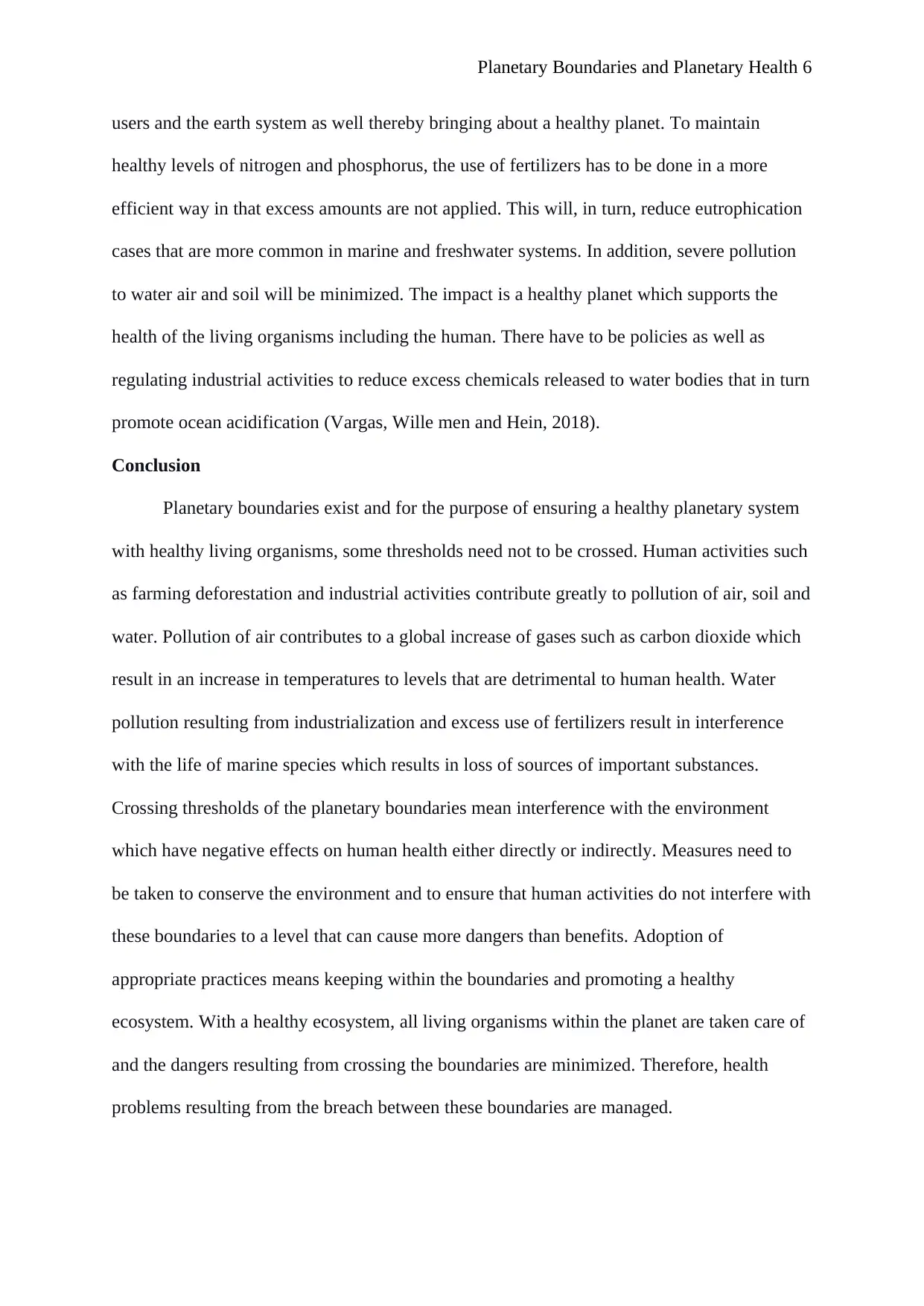
Planetary Boundaries and Planetary Health 6
users and the earth system as well thereby bringing about a healthy planet. To maintain
healthy levels of nitrogen and phosphorus, the use of fertilizers has to be done in a more
efficient way in that excess amounts are not applied. This will, in turn, reduce eutrophication
cases that are more common in marine and freshwater systems. In addition, severe pollution
to water air and soil will be minimized. The impact is a healthy planet which supports the
health of the living organisms including the human. There have to be policies as well as
regulating industrial activities to reduce excess chemicals released to water bodies that in turn
promote ocean acidification (Vargas, Wille men and Hein, 2018).
Conclusion
Planetary boundaries exist and for the purpose of ensuring a healthy planetary system
with healthy living organisms, some thresholds need not to be crossed. Human activities such
as farming deforestation and industrial activities contribute greatly to pollution of air, soil and
water. Pollution of air contributes to a global increase of gases such as carbon dioxide which
result in an increase in temperatures to levels that are detrimental to human health. Water
pollution resulting from industrialization and excess use of fertilizers result in interference
with the life of marine species which results in loss of sources of important substances.
Crossing thresholds of the planetary boundaries mean interference with the environment
which have negative effects on human health either directly or indirectly. Measures need to
be taken to conserve the environment and to ensure that human activities do not interfere with
these boundaries to a level that can cause more dangers than benefits. Adoption of
appropriate practices means keeping within the boundaries and promoting a healthy
ecosystem. With a healthy ecosystem, all living organisms within the planet are taken care of
and the dangers resulting from crossing the boundaries are minimized. Therefore, health
problems resulting from the breach between these boundaries are managed.
users and the earth system as well thereby bringing about a healthy planet. To maintain
healthy levels of nitrogen and phosphorus, the use of fertilizers has to be done in a more
efficient way in that excess amounts are not applied. This will, in turn, reduce eutrophication
cases that are more common in marine and freshwater systems. In addition, severe pollution
to water air and soil will be minimized. The impact is a healthy planet which supports the
health of the living organisms including the human. There have to be policies as well as
regulating industrial activities to reduce excess chemicals released to water bodies that in turn
promote ocean acidification (Vargas, Wille men and Hein, 2018).
Conclusion
Planetary boundaries exist and for the purpose of ensuring a healthy planetary system
with healthy living organisms, some thresholds need not to be crossed. Human activities such
as farming deforestation and industrial activities contribute greatly to pollution of air, soil and
water. Pollution of air contributes to a global increase of gases such as carbon dioxide which
result in an increase in temperatures to levels that are detrimental to human health. Water
pollution resulting from industrialization and excess use of fertilizers result in interference
with the life of marine species which results in loss of sources of important substances.
Crossing thresholds of the planetary boundaries mean interference with the environment
which have negative effects on human health either directly or indirectly. Measures need to
be taken to conserve the environment and to ensure that human activities do not interfere with
these boundaries to a level that can cause more dangers than benefits. Adoption of
appropriate practices means keeping within the boundaries and promoting a healthy
ecosystem. With a healthy ecosystem, all living organisms within the planet are taken care of
and the dangers resulting from crossing the boundaries are minimized. Therefore, health
problems resulting from the breach between these boundaries are managed.

Planetary Boundaries and Planetary Health 7
Reference
Banwell, N. et al. (2018) ‘Commonalities between disaster and climate change risks for
health: A theoretical framework’, International Journal of Environmental Research and
Public Health, 15(3).
Clements, J. C. and Chopin, T. (2017) ‘Ocean acidification and marine aquaculture in North
America: potential impacts and mitigation strategies’, Reviews in Aquaculture, 9(4), pp. 326–
341.
Diamond, M. L. et al. (2015) ‘Exploring the planetary boundary for chemical
pollution’, Environment International, 78, pp. 8–15.
Dilts, T. E. et al. (2016) ‘Multiscale connectivity and graph theory highlight critical areas for
conservation under climate change’, Ecological Applications, 26(4), pp. 1223–1237.
Karmalkar, A. V. and Bradley, R. S. (2017) ‘Consequences of global warming of 1.5 °c and 2
°c for regional temperature and precipitation changes in the contiguous United States’, PLoS
ONE, 12(1).
Moda, H. M., Leal Filho, W. and Minhas, A. (2019) ‘Impacts of Climate Change on Outdoor
Workers and Their Safety: Some Research Priorities’.
Myers, S. S. (2017) ‘Planetary health: protecting human health on a rapidly changing
planet’, The Lancet, 390(10114), pp. 2860–2868.
Reed, M. G. (2016) ‘Conservation (In)Action: Renewing the Relevance of UNESCO
Biosphere Reserves’, Conservation Letters, 9(6), pp. 448–456.
Shi, C. et al. (2015) ‘A study of aerosol optical properties during ozone pollution episodes in
2013 over Shanghai, China’, Atmospheric Research, 153, pp. 235–249.
Steffen, W. et al. (2015) ‘Planetary boundaries: Guiding human development on a changing
planet’, Science, 347(6223).
Reference
Banwell, N. et al. (2018) ‘Commonalities between disaster and climate change risks for
health: A theoretical framework’, International Journal of Environmental Research and
Public Health, 15(3).
Clements, J. C. and Chopin, T. (2017) ‘Ocean acidification and marine aquaculture in North
America: potential impacts and mitigation strategies’, Reviews in Aquaculture, 9(4), pp. 326–
341.
Diamond, M. L. et al. (2015) ‘Exploring the planetary boundary for chemical
pollution’, Environment International, 78, pp. 8–15.
Dilts, T. E. et al. (2016) ‘Multiscale connectivity and graph theory highlight critical areas for
conservation under climate change’, Ecological Applications, 26(4), pp. 1223–1237.
Karmalkar, A. V. and Bradley, R. S. (2017) ‘Consequences of global warming of 1.5 °c and 2
°c for regional temperature and precipitation changes in the contiguous United States’, PLoS
ONE, 12(1).
Moda, H. M., Leal Filho, W. and Minhas, A. (2019) ‘Impacts of Climate Change on Outdoor
Workers and Their Safety: Some Research Priorities’.
Myers, S. S. (2017) ‘Planetary health: protecting human health on a rapidly changing
planet’, The Lancet, 390(10114), pp. 2860–2868.
Reed, M. G. (2016) ‘Conservation (In)Action: Renewing the Relevance of UNESCO
Biosphere Reserves’, Conservation Letters, 9(6), pp. 448–456.
Shi, C. et al. (2015) ‘A study of aerosol optical properties during ozone pollution episodes in
2013 over Shanghai, China’, Atmospheric Research, 153, pp. 235–249.
Steffen, W. et al. (2015) ‘Planetary boundaries: Guiding human development on a changing
planet’, Science, 347(6223).
Paraphrase This Document
Need a fresh take? Get an instant paraphrase of this document with our AI Paraphraser
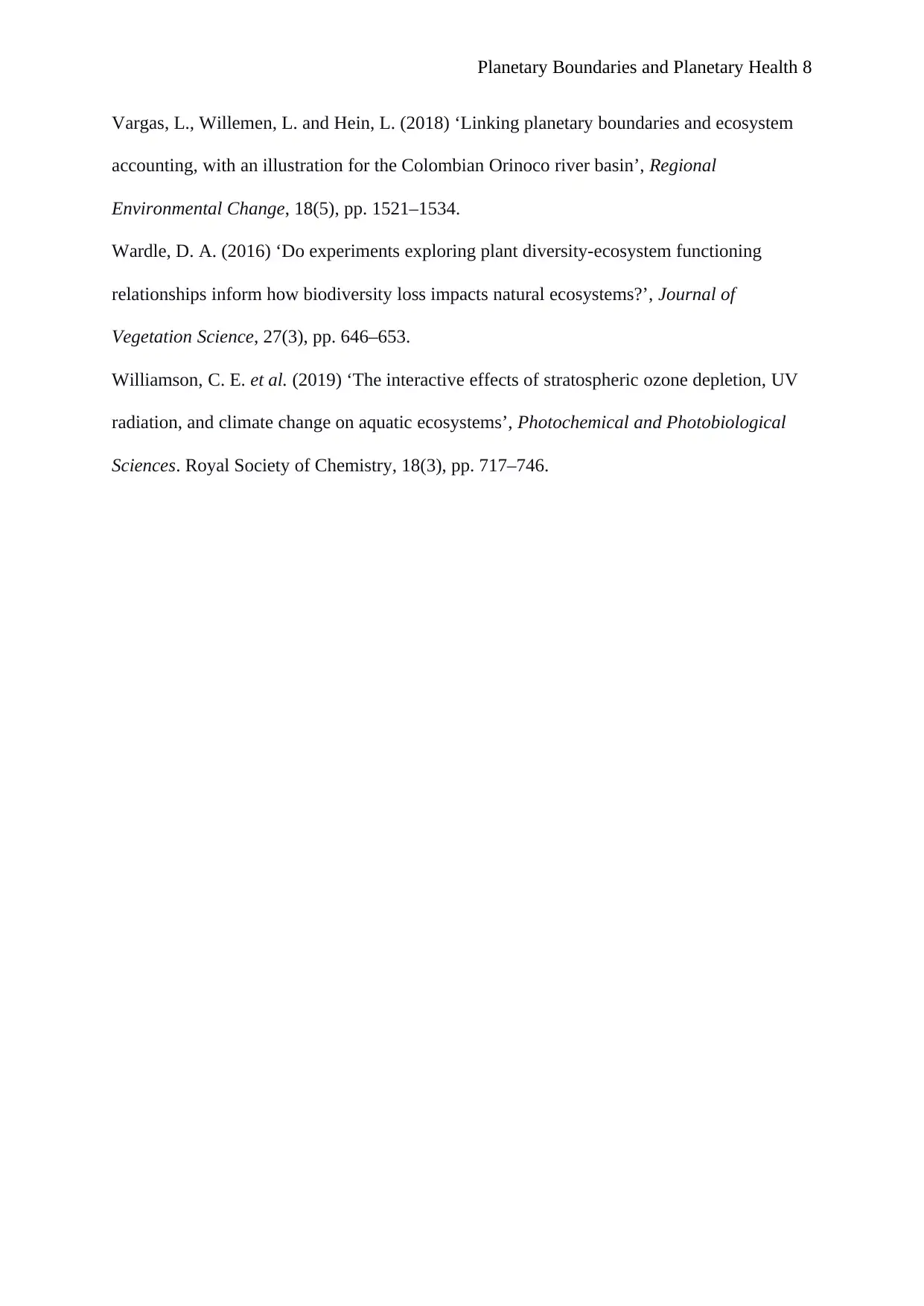
Planetary Boundaries and Planetary Health 8
Vargas, L., Willemen, L. and Hein, L. (2018) ‘Linking planetary boundaries and ecosystem
accounting, with an illustration for the Colombian Orinoco river basin’, Regional
Environmental Change, 18(5), pp. 1521–1534.
Wardle, D. A. (2016) ‘Do experiments exploring plant diversity-ecosystem functioning
relationships inform how biodiversity loss impacts natural ecosystems?’, Journal of
Vegetation Science, 27(3), pp. 646–653.
Williamson, C. E. et al. (2019) ‘The interactive effects of stratospheric ozone depletion, UV
radiation, and climate change on aquatic ecosystems’, Photochemical and Photobiological
Sciences. Royal Society of Chemistry, 18(3), pp. 717–746.
Vargas, L., Willemen, L. and Hein, L. (2018) ‘Linking planetary boundaries and ecosystem
accounting, with an illustration for the Colombian Orinoco river basin’, Regional
Environmental Change, 18(5), pp. 1521–1534.
Wardle, D. A. (2016) ‘Do experiments exploring plant diversity-ecosystem functioning
relationships inform how biodiversity loss impacts natural ecosystems?’, Journal of
Vegetation Science, 27(3), pp. 646–653.
Williamson, C. E. et al. (2019) ‘The interactive effects of stratospheric ozone depletion, UV
radiation, and climate change on aquatic ecosystems’, Photochemical and Photobiological
Sciences. Royal Society of Chemistry, 18(3), pp. 717–746.
1 out of 8
Related Documents
Your All-in-One AI-Powered Toolkit for Academic Success.
+13062052269
info@desklib.com
Available 24*7 on WhatsApp / Email
![[object Object]](/_next/static/media/star-bottom.7253800d.svg)
Unlock your academic potential
© 2024 | Zucol Services PVT LTD | All rights reserved.





